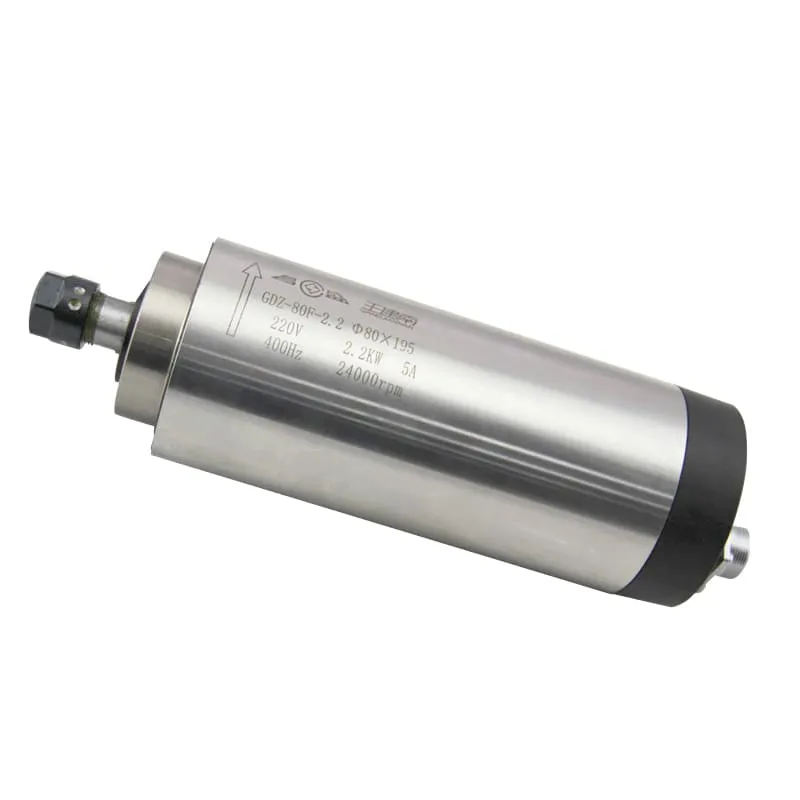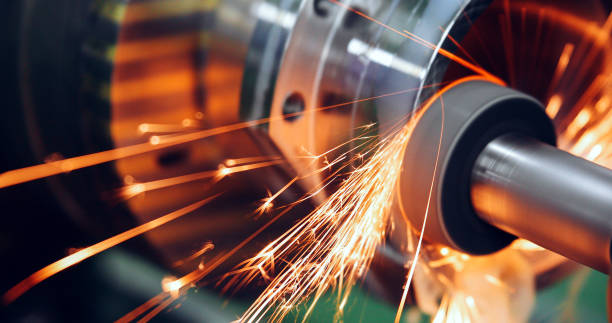How a CNC Lathe Works
CNC (Computer Numerical Control) lathes are sophisticated machine tools that automate the process of turning, which involves rotating a workpiece while a cutting tool shapes it. This comprehensive guide will explain how CNC lathes function, their components, and their role in modern manufacturing.
Understanding CNC Lathes
A CNC lathe is a computer-controlled machine tool used to perform turning operations. It combines the traditional lathe’s rotational cutting principles with the precision and automation of CNC technology.

A typical CNC lathe setup
Key Components of a CNC Lathe
- Main Spindle: Rotates the workpiece
- Tool Turret: Holds multiple cutting tools
- Tailstock: Supports long workpieces (on some models)
- CNC Controller: Computer that controls the machine’s operations
- Servo Motors: Drive the machine’s axes
- Coolant System: Manages temperature and removes chips
- Enclosure: Contains the machining area for safety
How CNC Lathes Operate
1. Programming
- G-code instructions are created using CAM software or manual programming
- The program defines tool paths, speeds, and other machining parameters
2. Setup
- The workpiece is mounted in the chuck or collet of the main spindle
- Cutting tools are loaded into the tool turret
3. Machining Process
- The CNC controller executes the program
- The main spindle rotates the workpiece at the specified speed
- The tool turret moves the cutting tools along the X and Z axes to shape the part
- For more complex parts, additional axes (like Y or C) may be utilized
4. Tool Changes
- The tool turret rotates to switch between different cutting tools as needed
- This process is automated and controlled by the CNC program
5. Measurement and Quality Control
- Many CNC lathes incorporate in-process measuring systems
- The machine can make automatic adjustments based on measurements
Types of CNC Lathes
- 2-Axis CNC Lathe: Basic model with X and Z axis movement
- 3-Axis CNC Lathe: Adds Y-axis for off-center milling operations
- 4-Axis CNC Lathe: Includes C-axis for rotary milling capabilities
- Multi-Axis CNC Turning Center: Combines turning and milling operations
Advantages of CNC Lathes
- Precision: Achieves tight tolerances consistently
- Efficiency: Automates repetitive tasks for faster production
- Complexity: Can produce complex shapes and features
- Repeatability: Ensures consistent quality across large production runs
- Flexibility: Easily switches between different part designs
Common CNC Lathe Operations
- Turning: Reducing the diameter of the workpiece
- Facing: Creating a flat surface on the end of the part
- Threading: Cutting internal or external threads
- Boring: Enlarging an existing hole
- Grooving: Cutting channels or recesses into the part
- Drilling: Creating holes along the centerline of the part
CNC Lathe vs. Manual Lathe
| Aspect | CNC Lathe | Manual Lathe |
|---|---|---|
| Precision | High, consistent | Depends on operator skill |
| Speed | Faster for complex parts | Can be faster for simple parts |
| Complexity | Can handle complex designs | Limited by operator skill |
| Setup Time | Longer initial setup | Quicker setup for simple parts |
| Operator Skill | Programming knowledge required | Traditional machining skills needed |
| Cost | Higher initial investment | Lower initial cost |
| Production Volume | Ideal for medium to high volume | Better for low volume or one-offs |
FAQ
1. How does a CNC lathe differ from a CNC mill?
A CNC lathe primarily rotates the workpiece against a stationary tool, while a CNC mill uses a rotating tool on a stationary workpiece.
2. Can a CNC lathe perform milling operations?
Many modern CNC lathes, especially multi-axis turning centers, can perform basic milling operations, blurring the line between lathes and mills.
3. What materials can be machined on a CNC lathe?
CNC lathes can machine a wide range of materials including metals, plastics, and even some woods. The choice of material affects cutting speeds and tool selection.
4. How accurate are CNC lathes?
Modern CNC lathes can achieve tolerances of ±0.0001 inches (0.0025 mm) or better, depending on the specific machine and setup.
5. What is the learning curve for operating a CNC lathe?
While basic operation can be learned relatively quickly, mastering CNC programming and advanced techniques can take several months to years.
6. How do CNC lathes improve manufacturing efficiency?
CNC lathes improve efficiency through automation, consistency, and the ability to run unattended for long periods, reducing labor costs and increasing production capacity.
Conclusion
CNC lathes represent a significant advancement in machining technology, combining the traditional principles of turning with the precision and automation of computer control. These machines have revolutionized the manufacturing industry by enabling the production of complex parts with high accuracy and consistency.
The operation of a CNC lathe involves a sophisticated interplay of mechanical, electronic, and software systems. From the initial programming stage to the final machining process, every aspect is carefully controlled to ensure precision and efficiency. The ability to automatically change tools, adjust cutting parameters, and even perform in-process measurements makes CNC lathes incredibly versatile and productive.
One of the key advantages of CNC lathes is their ability to handle complex geometries that would be difficult or impossible to achieve with manual machining. By utilizing multiple axes of motion and advanced programming techniques, these machines can create intricate profiles, precise threads, and even perform milling operations, all within a single setup.
The impact of CNC lathe technology extends beyond just the machining process. It has transformed the entire manufacturing workflow, from design to production. Computer-Aided Design (CAD) and Computer-Aided Manufacturing (CAM) software integrate seamlessly with CNC lathes, allowing for rapid prototyping and efficient transition from design to finished part.
However, it’s important to note that while CNC lathes offer numerous advantages, they also require a different skill set compared to traditional manual machining. Operators need to be proficient in CNC programming, understand G-code, and be familiar with CAM software. This shift has led to changes in workforce training and education within the manufacturing sector.
As manufacturing continues to evolve towards Industry 4.0 concepts, CNC lathes are becoming increasingly connected and data-driven. Integration with broader manufacturing execution systems, real-time monitoring, and predictive maintenance are becoming more common, further enhancing the efficiency and reliability of these machines.
In conclusion, understanding how CNC lathes work is crucial for anyone involved in modern manufacturing. These machines represent a perfect blend of traditional machining principles and cutting-edge technology, offering unparalleled precision, efficiency, and flexibility. As technology continues to advance, we can expect CNC lathes to play an even more significant role in shaping the future of manufacturing.

